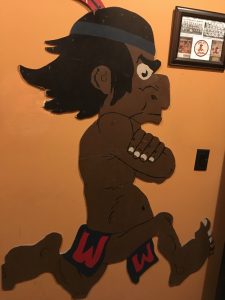Profile Final

A naked, beautiful woman with her face out of the frame. Her gorgeous body is arched back as if she is stretching her spine like a cat. Getting bombarded by nakedness when you first go into someone’s apartment is a sign that you should hightail it out of there, but this particular painting is anything but vulgar. It is awe inspiring. As I look around Patrick’s apartment that is what word comes to mind. Inspiring. His apartment is adorned with artifacts, paintings, and books from around the world. You can tell just by his apartment that he is an intellectual person.
In fact, Patrick Brett is one of the smartest people I’ve ever had the pleasure of speaking to. However, his IQ is paired with an unexpected level of humbleness. For example, it took him about an hour to confess that the paintings hung up around his apartment were painted by him. He signs them using an alias, as he wants to paint for the love of painting and not the credit.
Patrick is currently working for John Delaney’s campaign, who is seeking the Democratic nominee for President in 2020. Delaney thinks very highly of Patrick and praises his work towards the campaign. Since beginning his work for Delaney’s campaign, Patrick has quickly become one of his most valued workers.
Just a decade ago Patrick was couch surfing as a teenager just to make it through high school. Although his childhood isn’t something that he enjoys talking about, he has recently been asked to give the keynote address at a Court Appointed Special Advocates (CASA) summit to inspire kids that are going through similar situations as he did growing up. With this invitation, he figured he might as well get his information ready.
As we settled down for our interview he leaned back with his hands in his lap, seemingly relaxed. Patrick is a big guy. Not big as in overweight; the kind of big that drunk men would cower from in a bar brawl. With his short, blonde hair and piercing blue eyes, he seems like the type of golden boy that breezed through his childhood. That definitely was not the case.
We start with some basic information to loosen him up. Patrick was born in Winbur, Pennsylvania on August 16, 1991. He’s the second oldest of eleven children. His parents are Patrick and Marney. Growing up, his father worked as a laborer, mostly doing construction work. His mother was unemployed. One doesn’t have to be a genius to realize that having eleven children supported by a lone laborer’s pay doesn’t exactly work.
Patrick recalled when he was eight years old, he had to wear his father’s old shoes to his first day of school. Since he was the oldest boy, he had no hand-me-down clothes like the rest of his siblings. “We were all trying to find shoes to wear for school, trying to make do with whatever was laying around,” Patrick says.
He didn’t realize that his home life was different from everyone else’s until high school. “My family situation was kind of all consuming. I had no exposure to any healthy families. When I moved in with my dad at the age of 12, I was couch surfing through my dad’s friend’s houses. They weren’t nice houses. When I started dating girls was when I made the comparison with their families. Whenever it got to the point where I wanted to stay there rather than go home.” As Patrick recalled his experience, he looked to the ground as if in deep thought.
Finally meeting my eyes, he explained, “I never wanted to go home.”
The “ass-kickings”, as Patrick referred to them, started at the age of eight. That’s when the open handed hits turned into closed fists. Social services would get called on his family almost every month regarding Patrick’s continuous signs of abuse. His mother would beat him for any reason she could conjure. At such a young age, Patrick was continuously covered in bruises, black eyes, and, even at one point, choke marks. Strangely, he was the only one out of all his siblings that was beaten to that extent.
When social services would come talk to Patrick, they would call a week in advance to let his mother know. They also would let his mother sit in on their conversations, so there wasn’t much that Patrick could say. Before the meetings, his mother would remind him that if he told them anything, they would split their family up and he would never see his siblings again. Shaking his head, Patrick admits that she had that part right. He explained to me that a family of that size would never be able to find a home that would take all eleven of them.
When questioned about his mother’s mental health, his face shifted to anguish. He believes that she has some form of delusion disorder, possibly schizophrenia. There would be no way of knowing though, since she refuses to get checked. They know for sure that she has severe depression and has tried committing suicide mutliple times.
On one instance before she attempted committing suicide, she went as far as writing each of her children a letter. As her attempt failed, she was admitted into a hospital. Patrick found the letter intended for him and read it. Essentially, the letter said that she wished she had never had him and that she was disappointed in him.
As Patrick remembered the letter a great sorrow fell upon his face; it was almost as if he was that little kid again reading the letter for the very first time. “This is something that she consciously did and put into words on paper because she wanted this to be the last thing she ever left me.That was the first time I ever got completely and totally drunk. I got a bottle of vodka and drank so much”, he recited as if it was just yesterday.
He continued,“I had heard the things before but it was because they weren’t in the moment, she truly believed them.”
Finally, Patrick recalled at the age of twelve his mother had gone too far. In a fit of rage, she broke his cheek bone. Then when she went to choke him, he caught her hand. Once he finally stood up for himself, she kicked him out. In the middle of winter, Patrick made his way without a jacket to his friends house to call his dad to pick him up. His mother still denies abusing Patrick to this day. He honestly thinks that she might be so delusional that she actually believes it.
His parents had split when he was about seven years old. Afterwards, his father had an apartment with a friend of his for a while. That didn’t last long, though. After a couple of years, Patrick and his father left the apartment and couch surfed through his high school years. Once he graduated, he went straight into the marines since he didn’t really know what else to do. At that point, he didn’t know that college was an option.
Coincidentally, his parents found out about his high intelligence at around the same time the beatings began but Patrick didn’t find out until he was seventeen. His mother actually requested to check her son out for his mental health because she thought he was mentally handicapped. This could be because he was dyslexic, but Patrick confided that it was probably so he could get sent away to a special school for the school year. Patrick recalls that a man followed him around to every class for about a week or two and had him take a bunch of tests.
Patrick later took an IQ test before he went into the military to try and get grant money. When he took the test he found out that he had an IQ of 139, which categorizes him as a genius. When I asked him what percentile that puts him in, with a small smirk, he replied that he technically is one of the .1% smartest people in the world.
Through his intelligence, hequalified to join the group Mensa International, which is a high IQ society. As Patrick spoke about his intelligence, his face showed true pride. This was a drastic change from what he appeared to be feeling during the recollection of his childhood. He even joked that Arnold Schwarzenegger was in Mensa too.
“Finding out that I was a genius was huge for me”, Patrick exclaimed, “With being dyslexic and being made fun of, I was scared to go to college because I thought I was stupid.” But quite the opposite happened. Through college he got straight A’s as he attended Penn State for a political science degree.
Patrick will never forget his experiences though. He stopped talking to his parents at twenty years old. He keeps in touch with his siblings, but he hasn’t really been apart of the family since he left. His eyes grow sad when he speaks of his family and the lack of relationship there. On the outside, he says that he is better off without them but deep down there is still a hole.
Dylan Root, one of Patrick’s good friends, reflects on his relationship with Patrick. “He’s a very determined and headstrong person and it often comes through in his relationships.” He explains that Patrick takes the initiative with his friends, which is not something that you see in a lot of people. “He’s a decision maker, which works very well in our group of friends.” Dylan has only been friends with him for a couple of months, but in that short time it is obvious that Patrick has made an impact on him.
Through these experiences, Patrick has become the man that he is today. The resilient, strong-willed, intelligent, and humble man that cares so much about the world around him. He got into politics because he believes that it’s the one way he can help society. Personally, I have a feeling that Patrick could be making an impact on Sioux City and the political world in the near future.
Reflecting back on his childhood now, Patrick looks at it the only way he ever does, intellectually. “There’s a point in getting your ass kicked that you finally realize that your skin isn’t made out of paper and your bones aren’t made out of glass,” Patrick says matter of factly. “Whenever you reach that point you realize that if I can take that, there’s not much I can’t take. It made me resilient.”



